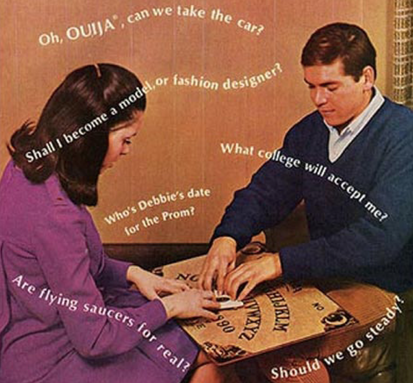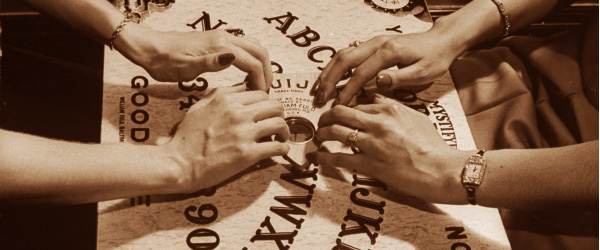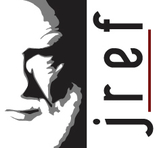By Bobby Nelson
Coming up around Halloween is a new movie based on the Ouija board. Popular culture ideas have a great impact on social acceptability and spread of beliefs. You can guarantee that the popularity of Ouija boards and the volumes of strange stories people tell about them will increase precipitously in conjunction with portrayals of totally fictional events.
One of the most controversial tools ever used in spirit communication, still used today, is a simple wooden board. It comes in many different sizes, with a variety of beautiful painted scenes and symbols. They all share certain characteristics. The surface of these boards will have inscribed the words “Yes”, “No” and “Goodbye“, the letters A through Z, and the numbers 0 through 9. The pointer, a planchette, is most typically a triangular or heart-shaped device that will point to the letters, numbers or words, spelling out phrases, names and dates. The planchette predates these boards, first seen in China a millennium ago and also used with a pencil attached for automatic writing (a method used regularly during the spiritualist movement of 19th century America.) Now the planchette and this board go hand in hand.
The board goes by many names - talking board, a witch board, spirit board - but most of us know it as the Ouija board.
Coming up around Halloween is a new movie based on the Ouija board. Popular culture ideas have a great impact on social acceptability and spread of beliefs. You can guarantee that the popularity of Ouija boards and the volumes of strange stories people tell about them will increase precipitously in conjunction with portrayals of totally fictional events.
One of the most controversial tools ever used in spirit communication, still used today, is a simple wooden board. It comes in many different sizes, with a variety of beautiful painted scenes and symbols. They all share certain characteristics. The surface of these boards will have inscribed the words “Yes”, “No” and “Goodbye“, the letters A through Z, and the numbers 0 through 9. The pointer, a planchette, is most typically a triangular or heart-shaped device that will point to the letters, numbers or words, spelling out phrases, names and dates. The planchette predates these boards, first seen in China a millennium ago and also used with a pencil attached for automatic writing (a method used regularly during the spiritualist movement of 19th century America.) Now the planchette and this board go hand in hand.
The board goes by many names - talking board, a witch board, spirit board - but most of us know it as the Ouija board.

The Ouija board is infamous. I would bet that most people reading this have heard a terrifying story that has either happened to a friend, or a friend of a friend, that involves the Ouija board. What is the history of this fascinating and popular tool of devilish mischief? Was it constructed under candlelight in a dark dungeon sometime in the Dark Ages? Or maybe it was created by a witch who practiced black magic and satanic rituals. Nope. The Ouija board is fairly young and it was made as a novelty item.
On May 28th 1890, a patent was filed by Elijah Bond, Charles W. Kennard and William H. A. Maupin for the item developed by The Kennard Novelty Company. The first boards were stamped February 10, 1891. Kennard named the board Ouija. People say the name Ouija means yes-yes because oui is French for yes and ja is German for yes, but Kennard claims the board itself repeatedly told him that Ouija meant good luck in Egyptian and the name stuck. The company only produced the Ouija board for fourteen months but kept corporate control until 1898 at which time the Ouija board was appointed to a man that would revolutionize the board’s history, William Fuld.
Fuld said that he invented the board and that the name did in fact mean yes-yes. In 1919, Fuld bought the remaining rights and sold millions of these boards along with other toys. Fuld would die from a horrible accident when he fell from his company’s rooftop while supervising a flag pole replacement. Fuld’s children took over the business and the production of Ouija boards. In 1966, the business was sold to Parker Brothers toy company, which was subsequently sold to Hasbro who now holds the rights to the Mystifying Oracle. [Source]
So when did the Ouija Board turn evil? The history seems generally harmless, how did it go from a toy, a novelty item, to being associated with Satan and demons? While use of the board was always criticized by scientists and some religious authorities, the majority of “evil” reports relating to the board came about in the 70’s, after a novel was published which was made into a blockbuster movie two years later. The story was about a teenage girl who tells her mother she has been talking to a person named “Captain Howdy” through the Ouija board. Later this girl becomes possessed by the devil, which causes her body to contort, she spits up green vomit and her head spins 360 degrees (among other extraordinary events). This iconic film, of course, is “The Exorcist” (responsible for the current popular culture perception of demonic possession.)
The Exorcist is “based” on a “true” story of a 14-year-old boy who was said to be possessed, requiring three separate Rites of Exorcism. It is also said that these sacred rituals came from three different Christian denominations: Episcopalian, Lutheran, and Roman Catholic. The case happened in 1949 and the boy did admit to playing with a Ouija board. Christian groups had already been speaking out against the device when this claim came out. Since the idea that that such an instrument could contact the dead carries heavy religious implications, so it is not unreasonable to see why the Church might be inclined to conclude this was the reason behind the supposed possession. However, after 1973 (the year The Exorcist movie was released) claims linking Ouija boards and demons skyrocketed. It’s not just the movie, it was the heavy promotion by Christians that gave the Ouija its reputation as the work of the devil.
On May 28th 1890, a patent was filed by Elijah Bond, Charles W. Kennard and William H. A. Maupin for the item developed by The Kennard Novelty Company. The first boards were stamped February 10, 1891. Kennard named the board Ouija. People say the name Ouija means yes-yes because oui is French for yes and ja is German for yes, but Kennard claims the board itself repeatedly told him that Ouija meant good luck in Egyptian and the name stuck. The company only produced the Ouija board for fourteen months but kept corporate control until 1898 at which time the Ouija board was appointed to a man that would revolutionize the board’s history, William Fuld.
Fuld said that he invented the board and that the name did in fact mean yes-yes. In 1919, Fuld bought the remaining rights and sold millions of these boards along with other toys. Fuld would die from a horrible accident when he fell from his company’s rooftop while supervising a flag pole replacement. Fuld’s children took over the business and the production of Ouija boards. In 1966, the business was sold to Parker Brothers toy company, which was subsequently sold to Hasbro who now holds the rights to the Mystifying Oracle. [Source]
So when did the Ouija Board turn evil? The history seems generally harmless, how did it go from a toy, a novelty item, to being associated with Satan and demons? While use of the board was always criticized by scientists and some religious authorities, the majority of “evil” reports relating to the board came about in the 70’s, after a novel was published which was made into a blockbuster movie two years later. The story was about a teenage girl who tells her mother she has been talking to a person named “Captain Howdy” through the Ouija board. Later this girl becomes possessed by the devil, which causes her body to contort, she spits up green vomit and her head spins 360 degrees (among other extraordinary events). This iconic film, of course, is “The Exorcist” (responsible for the current popular culture perception of demonic possession.)
The Exorcist is “based” on a “true” story of a 14-year-old boy who was said to be possessed, requiring three separate Rites of Exorcism. It is also said that these sacred rituals came from three different Christian denominations: Episcopalian, Lutheran, and Roman Catholic. The case happened in 1949 and the boy did admit to playing with a Ouija board. Christian groups had already been speaking out against the device when this claim came out. Since the idea that that such an instrument could contact the dead carries heavy religious implications, so it is not unreasonable to see why the Church might be inclined to conclude this was the reason behind the supposed possession. However, after 1973 (the year The Exorcist movie was released) claims linking Ouija boards and demons skyrocketed. It’s not just the movie, it was the heavy promotion by Christians that gave the Ouija its reputation as the work of the devil.
Here is the trailer to the new movie to be released on Oct 24, 2014.
I have personally received many accounts of strange Ouija board activity, mostly second- or third- hand. The claimants assure me that evil has been associated with their board for as long as they can remember. However, hardly any of the stories directly cite an association with demons or possession with them. Instead, the claimants were told that the board was evil by clergy or family members with strong religious views. This reinforces the idea that the Church played a large role in why this toy is considered dangerous.
Most Christian denominations view spirit communication as a product of evil or the work of the devil. According to the teachings I learned growing up as a Lutheran (Missouri Synod), a spirit either goes to Heaven or Hell. I have even been told that ghosts are demons portraying loved ones to win over trust so we will “let them in.” Therefore, the Ouija board as a spirit communication tool is a no-no, and The Exorcist shock value bolstered the idea tremendously.
It is easy to see how someone can trick themselves into believing that supernatural forces are behind the movement of the Ouija planchette. Though the planchette is being moved, it is not by demons or spirits but by the participants themselves. The answer lies with the “ideomotor effect,” which was coined by William B. Carpenter in 1852. With the power of suggestion or expectation and the subtle unconscious movements made by the hands, it may appear that something supernatural is occurring. The planchette appears to be moving on its own. Carpenter also noted that the muscle movements can be made by the brain independently of emotions. To put it simply, we don’t know that we are the ones influencing the planchette to move. This same effect applies to use of pendulums and dowsing rods.
Another common factor in the Ouija stories I have received (and have heard in the past) is that most of them end with someone burning the board to get rid of the “evil”, but to their surprise it isn’t affected by the flames. Many other stories tell of the smell of burning flesh when the board is thrown in the fire pit, even a board screaming in the flames. But the biggest commonality is that the fire has no effect on the board. Could this stem from the belief that the Ouija board is closely connected with demons and the Devil, and the belief that fire is associated with Hell? It is difficult for me to believe something made out of wood could survive the fire.
I contacted skeptical investigator James “The Amazing” Randi, to talk about this. Randi has tested use of the Ouija board. To demonstrate it is nothing more than the ideomotor effect, he blindfolded the operators, and the results produced were nothing but nonsense. No words, names, or phrases, no "yes", "no" or dates–it was only gibberish. Surely demons or evil spirits would be able to spell regardless if the operator is blindfolded or not, so what happened? The logical explanation according to Randi is that it’s all done subconsciously by the operator. When the operator can’t see the board, the operator can’t produce positive results. When we conversed about the legend that Ouija boards do not burn in fire, Mr. Randi told me to present everyone interested with an experiment, in his words: “Have everyone go out and buy a Ouija board and set it on fire. If it doesn’t burn, they’ll win a million dollars.” (Not really, but see the Million Dollar Challenge)
In the end it seems that myths conveniently become “fact” for those willing to believe. The Ouija board is and has always been a board game, a novelty item, a toy. It has never been and is not a portal to Hell; it does not let entities of any sort in through some invisible portal. It does not conjure demons or Satan himself. I took the challenge and tested myself whether or not the board burns. Well, it does in fact burn... GASP! I heard no screaming, I smelled no burning flesh. It also did not reappear on the mantle magically rejuvenated. It was just a waste of 15 dollars.
Most Christian denominations view spirit communication as a product of evil or the work of the devil. According to the teachings I learned growing up as a Lutheran (Missouri Synod), a spirit either goes to Heaven or Hell. I have even been told that ghosts are demons portraying loved ones to win over trust so we will “let them in.” Therefore, the Ouija board as a spirit communication tool is a no-no, and The Exorcist shock value bolstered the idea tremendously.
It is easy to see how someone can trick themselves into believing that supernatural forces are behind the movement of the Ouija planchette. Though the planchette is being moved, it is not by demons or spirits but by the participants themselves. The answer lies with the “ideomotor effect,” which was coined by William B. Carpenter in 1852. With the power of suggestion or expectation and the subtle unconscious movements made by the hands, it may appear that something supernatural is occurring. The planchette appears to be moving on its own. Carpenter also noted that the muscle movements can be made by the brain independently of emotions. To put it simply, we don’t know that we are the ones influencing the planchette to move. This same effect applies to use of pendulums and dowsing rods.
Another common factor in the Ouija stories I have received (and have heard in the past) is that most of them end with someone burning the board to get rid of the “evil”, but to their surprise it isn’t affected by the flames. Many other stories tell of the smell of burning flesh when the board is thrown in the fire pit, even a board screaming in the flames. But the biggest commonality is that the fire has no effect on the board. Could this stem from the belief that the Ouija board is closely connected with demons and the Devil, and the belief that fire is associated with Hell? It is difficult for me to believe something made out of wood could survive the fire.
I contacted skeptical investigator James “The Amazing” Randi, to talk about this. Randi has tested use of the Ouija board. To demonstrate it is nothing more than the ideomotor effect, he blindfolded the operators, and the results produced were nothing but nonsense. No words, names, or phrases, no "yes", "no" or dates–it was only gibberish. Surely demons or evil spirits would be able to spell regardless if the operator is blindfolded or not, so what happened? The logical explanation according to Randi is that it’s all done subconsciously by the operator. When the operator can’t see the board, the operator can’t produce positive results. When we conversed about the legend that Ouija boards do not burn in fire, Mr. Randi told me to present everyone interested with an experiment, in his words: “Have everyone go out and buy a Ouija board and set it on fire. If it doesn’t burn, they’ll win a million dollars.” (Not really, but see the Million Dollar Challenge)
In the end it seems that myths conveniently become “fact” for those willing to believe. The Ouija board is and has always been a board game, a novelty item, a toy. It has never been and is not a portal to Hell; it does not let entities of any sort in through some invisible portal. It does not conjure demons or Satan himself. I took the challenge and tested myself whether or not the board burns. Well, it does in fact burn... GASP! I heard no screaming, I smelled no burning flesh. It also did not reappear on the mantle magically rejuvenated. It was just a waste of 15 dollars.
Modified from a piece originally published in The Bent Spoon 1:3 July 2011
Bobby Nelson is a ghost hunter turned Skeptic, investigator of paranormal claims, and the host of Strange Frequencies Radio.


